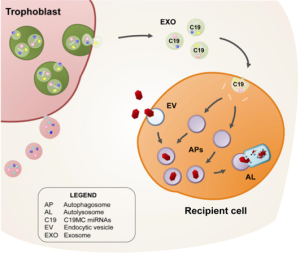 Hosts: Vincent Racaniello, Alan Dove, Rich Condit, and Kathy Spindler
Hosts: Vincent Racaniello, Alan Dove, Rich Condit, and Kathy Spindler
Vincent, Alan, Rich and Kathy review how human placental trophoblasts confer viral resistance via exosome-mediated delivery of microRNAs, and isolation of the first human influenza virus in 1933.
Click arrow to play
Download TWiV 241 (73 MB .mp3, 101 min)
Subscribe (free): iTunes, RSS, email
Links for this episode:
- Human placental trophoblasts confer viral resistance (PNAS)
- Placental circulation (Wikipedia)
- Ovum in uterine decidua (Wikipedia)
- A virus obtained from influenza patients (Lancet)
- 80 years ago today (the guardian)
- Influenza: Exposing the true killer (J Exp Med)
- Letters read on TWiV 241
Weekly Science Picks
Kathy – Bats use blood to reshape tongue
Alan – Science Studio
Vincent – Steel bacteriophage lamp
Rich – Nobel Prize Chemistry 2009 (pdf); By ribosome possessed
Listener Pick of the Week
Joe – Grand challenges in science education (Science)
Mark – Weather Underground
Send your virology questions and comments (email or mp3 file) to [email protected]


In response to the “why are RNA viruses generally more compact than DNA viruses”.
There was talk about the fact they are smaller may be because you want less room for error, as RNA is going to replicated less consistently. But isn’t this a falsehood when you a bigger virus may have the chance to encode multiple copies of genes, or a mechanism to make replication more accurate?
Is it not these smaller viruses that use techniques such as frame-shifting to get more proteins encoded from their less sequence? Wouldn’t this lead the sequence to be more prone to errors as well?
Re: Placentas
They don’t always go to medical waste. Some women have been following the habits of animals and opting to eat their placentas.
Some choose to have the placenta made into easy to swallow capsules, while others prefer a placenta smoothie, placenta lasagne, or a dinner of placenta sautéed with wine and shallots. (Think I’m kidding? Google “Placenta Recipes” and see for yourself!)
Done gagging yet?